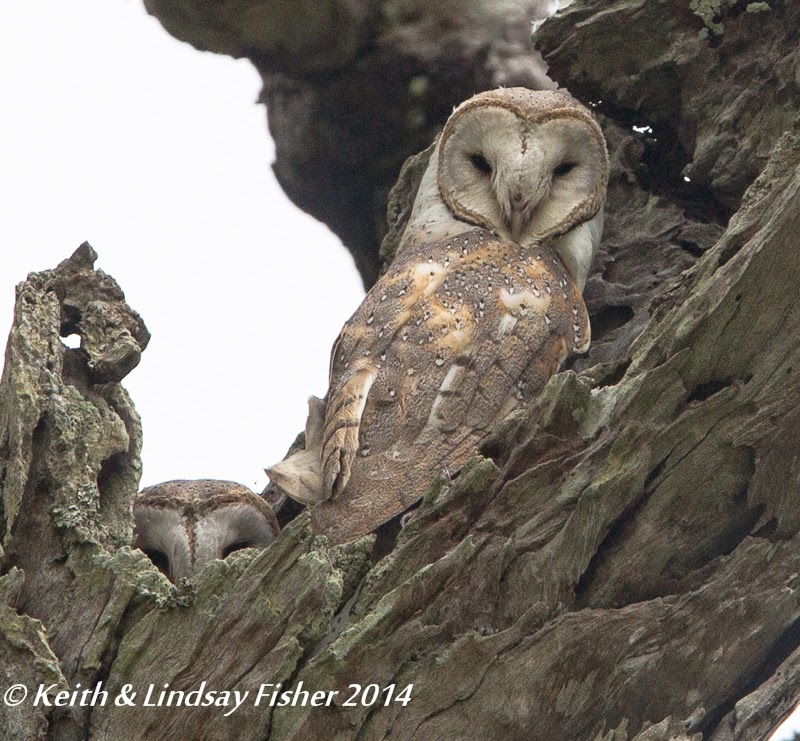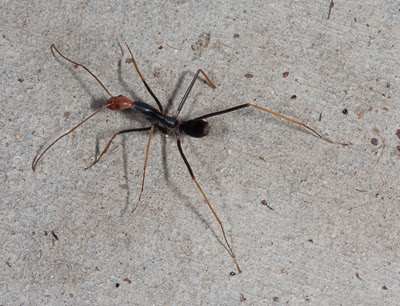11th
January 2015 Kingfisher Park Birdwatchers Lodge
Weather
Report
The last month has seen some good
rains with plenty of sunny days, hot cool and humid with temperatures
in the range from 21.2ºC minimum to a maximum on one day of a hot 35ºC but generally around 28-32ºC for top temperatures.
Rainfall was 81.5mm.
Last Four Weeks Bird Sightings:-
These
can be found on the Eremaea eBird site. 14th - 20th December 2014, 21st - 27th December 2014,
28th December 2014 - 3rd January 2015, and 4th - 10th January 2015 Species numbers were down due to a reduced effort over the Christmas/New Year period when we were very busy with guests.
Birding
Highlights:-
Due
to the rain managing to fill up a few low lying areas there was
plenty of opportunities for waterfowl to spread out to the detriment
of the local lagoons which were very quiet with only a few Magpie
Goose, Pacific Black Duck, Grey Teal, a single Australasian Grebe,
Great and Intermediate Egret, one Little Pied Cormorant, one
Australasian Pelican plus a few Cattle Egret who disappeared before
Christmas back to their breeding grounds. Raptors were also scarce as the local cane harvest wound
down, the hoards of Black Kite left and only the odd one or two were
left, the pair of local Whistling Kite stayed as did a couple of
White-bellied Sea-Eagle. A single Grey Goshawk was seen one week
being chased off by a few Sulphur-crested Cockatoo. Good news is that
our pair of Red-necked Crake continue to be seen around the Lodge
grounds, mainly at the Crake Pool in the orchard. There has been a big
influx of Pale-vented Bush-hen this season with at least 7-8 pairs around the
lodge area. Trying to see them is another matter as they rarely
venture out from the grassy areas along Bushy Creek and the local
roads.
The odd Buff-banded Rail does make an appearance, usually alongside the cane fields or Bushy Creek. A White-browed Crake was seen in one of the McDougall Road Lagoons. The local pair of Bush Stone-curlew continue to look after their youngster (featured in the last blog), who is now almost as big as his parents as this updated photo shows, he is the one on the far right.
 |
| Pale-vented Bush-hen |
The odd Buff-banded Rail does make an appearance, usually alongside the cane fields or Bushy Creek. A White-browed Crake was seen in one of the McDougall Road Lagoons. The local pair of Bush Stone-curlew continue to look after their youngster (featured in the last blog), who is now almost as big as his parents as this updated photo shows, he is the one on the far right.
 |
| Bush Stone-Curlew |
Plenty
of pigeons and doves around with the usual Bar-shouldered Dove,
Peaceful Dove, and Emerald Dove, these being the most common. Wompoo and
Superb Fruit-Dove are around but hard to see and Torresian
Imperial-Pigeon have mainly left with the occasional flock passing
through. Brush Cuckoo have become noisy and displaying as the rain
increases but the Australian Koel have become quiet along with the
Channel-billed Cuckoo. Lesser Sooty Owl have only been heard
occasionally as have Barking Owl, the Barn Owl are regularly around
but not calling much at this time of year. We seem to be down to one
Papuan Frogmouth in the Lodge grounds now that our pair failed with their nest attempt but
another nearby nest, which was successful still have their youngster
with them as this photo shows.
 |
| Papuan Frogmouth - female with immature |
Buff-breasted
Paradise-Kingfisher have dug out their nest in the termite mounds but
don't appear to be sitting yet. One pair was seen mating a few days
ago so it should not be long until they lay, they are about a month
behind their usual breeding period due to the dry weather we have
been having. Yes another Buff-breasted Paradise-Kingfisher photo! You can't help taking photos of them as they are so photogenic.
Red-tailed Black-Cockatoo were seen flying over at the end of December which is the normal pattern each year, they are usually in the area until about the end of February. It looks like we only have one pair of Noisy Pitta this year instead of the normal two pairs as only two have been seen at a time. Hopefully they are nesting now. Yellow-breasted Boatbill are in full song and Pied Monarch have also started to call again. A few Barred Cuckoo-shrike and Cicadabird are around and calling. Australasian Figbird have been nesting as have Willie Wagtail. This one was in our orchard sitting on its minimalist nest.
 |
| Buff-breasted Paradise-Kingfisher |
Red-tailed Black-Cockatoo were seen flying over at the end of December which is the normal pattern each year, they are usually in the area until about the end of February. It looks like we only have one pair of Noisy Pitta this year instead of the normal two pairs as only two have been seen at a time. Hopefully they are nesting now. Yellow-breasted Boatbill are in full song and Pied Monarch have also started to call again. A few Barred Cuckoo-shrike and Cicadabird are around and calling. Australasian Figbird have been nesting as have Willie Wagtail. This one was in our orchard sitting on its minimalist nest.
Still
no sign of Black-faced Monarch nesting but Spectacled Monarch have
had a few nests around the Lodge. Metallic Starling are still
attending nests and into their second breeding cycle along with
adding more nesting material to the communal nests. A couple of
Double-barred Finch were seen by our neighbours Carol and Andrew Iles
(bird guides), these are uncommon around the Lodge with one or two
sightings a year. They are more common around Mt. Molloy.
Chestnut-breasted Mannikin have been seen carrying nesting material
as well as displaying as this one is doing.
 |
| Chestnut-breasted Mannikin |
Further
Afield:-
Most
of the sightings from further afield are from Mt. Lewis where all the
13 “Wet Tropic” endemics have been seen over the last month. A
few Lesser Sooty Owl have been seen and a possible Masked Owl was
heard. Male Golden Bowerbird have been seen but are not easy to find.
The other endemics, Fernwren, Atherton Scrubwren, Mountain Thornbill,
Macleay's Honeyeater, Bridled Honeyeater, Grey-headed Robin,
Chowchilla, Bower's Shrike-thrush, Pied Monarch and Tooth-billed
Bowerbird have been reasonably easy to find. Blue-faced Parrot-Finch
have been scarce with up to four birds seen at any one time around
the 10km clearing on Mt. Lewis. Tinaburra Peninsula, near Yungaburra
on the Atherton Tableland has had an influx of Red-rumped Swallow
with up to 38 seen by Alan Gillanders from Alan's
Wildlife Tours, Also in the same area at Harper Road, Lake
Tinaroo there was a Ruff.
Reptiles
and Mammals:-
Green
Tree Snake have been active with three seen in one week eating
White-lipped Tree Frog. One 3.5m Australian Scrub Python was seen
coiled up on the edge of the orchard, whilst we were on a night walk,
before it moved off into the rainforest. The wetter weather got the
frogs going with Jungguy Frog, White-lipped Tree Frog, Northern Dwarf
Tree Frog, Desert Tree Frog, Dainty Green Tree Frog, and Cogger's
Frog seen plus Green Tree Frog and Roth's (Laughing) Tree Fog heard.
A few Northern Leaf-tailed Gecko were seen but they are difficult to find at this time of year. Boyd's Forest Dragon and Easter Water Dragon have been easier to find. Three Platypus were seen in Bushy Creek, two adults and a juvenile which was great. Also seen in Bushy Creek was a Water Rat, which have not been seen lately. Both Green Ringtail and Striped Possum have been seen but again they have been difficult to find. Fawn-footed Melomys and Yellow-footed Antechinus have been around, the antechinus coming to take banana from the reception area feeder. Northern Broad-nosed Bat have been roosting under our neighbours house which is where this one was found.
 |
| Jungguy Frog - male in breeding colours |
 |
| Cogger's Frog |
A few Northern Leaf-tailed Gecko were seen but they are difficult to find at this time of year. Boyd's Forest Dragon and Easter Water Dragon have been easier to find. Three Platypus were seen in Bushy Creek, two adults and a juvenile which was great. Also seen in Bushy Creek was a Water Rat, which have not been seen lately. Both Green Ringtail and Striped Possum have been seen but again they have been difficult to find. Fawn-footed Melomys and Yellow-footed Antechinus have been around, the antechinus coming to take banana from the reception area feeder. Northern Broad-nosed Bat have been roosting under our neighbours house which is where this one was found.
 |
| Northern Broad-nosed Bat |
Spiders:-
Quite
a few spiders around including many Wolf Spiders which appear to all
be the same species (over 150 species in Australia). These two pictures show the whole spider and a
close up of the head and body showing the eyes in a 4-2-2
configuration (sounds like a soccer match!).
This jumping spider was no bigger than a 5c piece and shows the amazing patterning in such a small creature. It is possibly Jacksonoides queenslandicus, thanks to Robert Whyte for the information.
 |
| Wolf Spider |
 |
| Wolf Spider - Head and body |
This jumping spider was no bigger than a 5c piece and shows the amazing patterning in such a small creature. It is possibly Jacksonoides queenslandicus, thanks to Robert Whyte for the information.




































